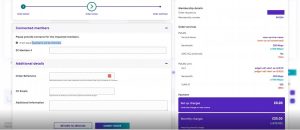LINX Member Portal Self-Service Edit Features (Part 1) – Overview and Functionality
The LINX Member Portal, and its self-service functionality, is a technically advanced system that allows LINX member networks greater control over the provisioning of services on their ports. The on-demand features simplify processes and frees up time for both the member, and LINX teams.
Until now, the functionality in the portal for members was limited to ordering these services but they were not able to request changes through the portal. Instead, they had to contact the NOC or Sales teams. This is what is being addressed now in this new phase of portal development.
With the latest upgrade, all add-on services delivered across the members ports, meaning peering services, Private VLAN (PVLAN), Closed User Groups (CUGs), Cloud Connect (CC), and Microsoft Azure Peering Service (MAPS) are now easy for members to change at any point.
In a member’s My Services section they can now select their individual network services and make specific edits such as changes to bandwidth, MAC address updates, change VLAN IDs, migrate between ports or move to new ports and, if no longer required, request the cancellation of particular products.
The aim of this upgrade is to further improve the ease of doing business with LINX, with the benefit of shorter notice and invoice periods for updates on member networks.
Riccardo Verzeni, LINX’s Director of Software Engineering, said,
“Where once network changes could take days and hours to implement, it now takes minutes and seconds.“
“The release of the latest phase of self-service functions will include manual ordering through the portal. While this will initially still require completion via the LINX NOC, the process will be fully automated thereafter.”
Private VLAN (PVLAN) – Product Overview & Functionality
LINX PVLAN allows two members to access services directly from each other using the existing LINX infrastructure. This reduces the amount of infrastructure and cross connects needed by members.
The service is available to members on the LON1 and LON2 networks in London, at LINX Manchester, and LINX NoVA in the US.
The following screenshots show the general user interface (UI) for the PVLAN product which, for the most part, will be reflected for other LINX Portal self-service product functions.
In My Services, select the service you want to edit using the purple icon on the right of the screen. A number of editable fields will appear and when changed will display any cost changes in real time, so you are able to assess your options before you submit your order.
If another member is affected there is the ability to input a specific email address. If not added, this will default to the main contact of that member.
As you can see from the screenshot above, the changes have been highlighted in different colour fonts making it simpler to track the updates before the order is submitted.
In this case the fellow member using the PVLAN service will get an invite where they can accept or reject a request. The status for the order is updated to show the stage of the process the order is at in the Order and Tracking details.
A DeskPro ticket is automatically issued for the NOC team to complete the order.
If you want to know more about self-service functionality and latest enhancements on the LINX Member Portal, please contact us using the form below.
We are a London based internet exchange company. For over 20 years, LINX has helped many organisations through our peering services.
< Go Back






